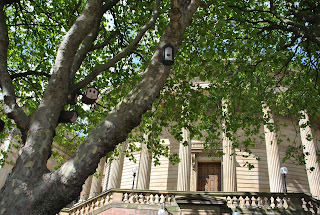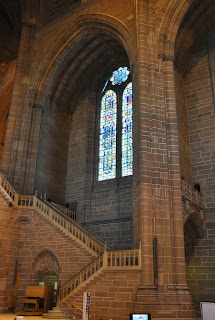On Wednesday we arrived once again in Liverpool. We had been
here before on Princess with Michel and Judy, but decided to explore the Lake
District on that trip. This time we were determined to see something of the
city, although we had no idea what to expect of it, since almost everyone who
isn't Liverpuddlian to start with only associates the city with its main
entertainment export - The Beatles.
We had found a city tour with a Tours by Locals guide, Neil,
and had arranged with another couple on the ship, David and Gerri, who were
doing the same one to share the tour. We had found previously that Tours by
Locals guides are very knowledgeable and, because they are driving their cars,
able to get to places that the big coaches can't reach, and they're able to
make unscheduled but interesting stops along the way.
Neil met us at the pier; we piled into his small but roomy
Toyota and set off. Liverpool has historically been the main shipping and
shipbuilding city in northern England, but because the River Liffey has a high
tidal variation it was very difficult to load and unload ships as they would
literally keel over at low tide. So the local folk, knowing that controlling
this would be imperative to their continuing success as a port, came up with
the imaginative idea of building a lock and canal system where they could
artificially keep the water level high when the tide went out so on and
off-loading would not be disrupted. So the Liverpool waterfront is really a
whole series of canals where the various Docks are located. The canals are
still in use now, but only for recreation. The Albert Dock area has been redeveloped as
an entertainment hub with restaurants, bars and shops.
 |
| Canal boats - some look lived-in like in Amsterdam and London |
Next Neil took us to the Liverpool Cathedral, an absolutely
amazing building that, despite its appearance, was actually built in the 20th
century,over a 60 year period. The architect, Sir Giles Gilbert Scott, didn't
quite see it finished. There had been a
design competition for the building in the 1910s, and it was ultimately won by
Scott, who at the time was in his early 20s. His father was also a well-known
architect so the church figured that the father had been involved in the design
and it was getting two for the price of one, but that wasn't the case, and
despite a number of setbacks as it went along, the younger Scott finally had
his design come to life. It is the
largest Anglican cathedral in Europe - it looks big from the outside but even
larger inside. The information pamphlet for the cathedral says 'the staggering
architecture will make your jaw drop!', and it is completely correct.
 |
| The hill where the Cathedral is built used to have a cemetery. The remains were all relocated and some of the gravestones now form the walkway around the Cathedral's front side |
Since we were still on the subject of churches, our next
stop was the Catholic Metropolitan Cathedral of Christ the King Liverpool. It
is a very modern building built in the 1960s, but with a history that goes back
to 1933. As the story goes, the relatively small Catholic community - remember
England has been predominantly Anglican for a very long time - decided it
wanted to build the biggest Catholic cathedral in Europe (did they forget about
St. Peter's?) and had Sir Edward Lutyens design the building. They got as far
as building the Crypt, the underground section, before they ran out of money. A
visit to the Crypt (which we didn't do) would show just how overly ambitious
their design really was. When they ran out of money again, and couldn't get any
help from Rome, they had to redesign the cathedral to fit their budget. This
picture, from the visitors' brochure, it what they ended up with:
Even so, it wasn't built with the best quality, and the
ultimate cost of fixing things in the 1980s was almost half of the original
building cost. But despite its rather odd exterior, Paddy's Wigwam, as it is
affectionately called, is quite beautiful on the inside:
 |
| The cathedral is deceptive from the outside; the interior is much larger, able to hold 2,300 people for Mass. The altar is in the centre |
Even after all that, the Cathedral has been visited by both Queen
Elizabeth and Pope John Paul II and many people believe that Liverpool would
not be the city it is now without it.
A few other stops around town included:
 |
| The Chinatown Gate - very impressive considering Chinatown only has 2 streets |
 |
| The main Library - look at the birdhouses in the tree |
 |
| The World Museum and Queen Victoria's statue |
Of course, this being Liverpool, there had to be a Beatles
section to the tour. This was one of David's requests as he was a big Beatles
fan - but not so much of one that he had to visit their childhood homes, etc,
etc. So we took a walk through a few streets around the Cavern Club where the
guys used to hang out.
We finished off the tour with a short stop at Castle Street
to see the beautiful architecture of the main shopping area and a brief look
into the foyer of the Town Hall. Some of the silver pieces on display there are
quite lovely, including some gifts given to the city by wealthy citizens in
Liverpool's history.
 |
| Castle Street |
 |
| The Town Hall Foyer |
That evening, our main show was a Beatles tribute group
doing a lot of the earlier hits that everyone would know.
Our friend Keith made the original suggestion that this
group should be booked on our Liverpool stop after seeing them during the last
world cruise, so we have him to thank for a great evening's entertainment. The
show was so good, we went twice!!
















No comments:
Post a Comment